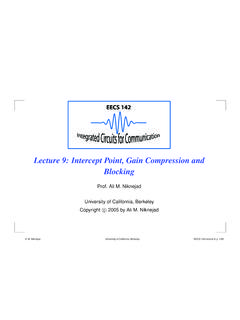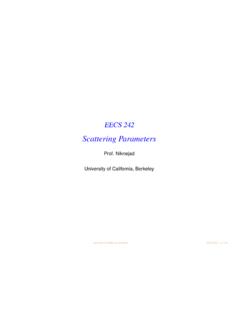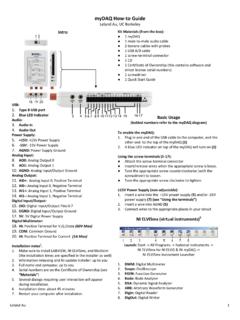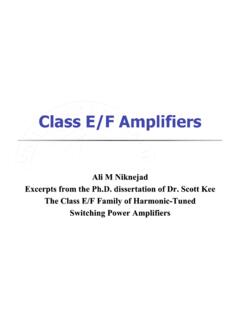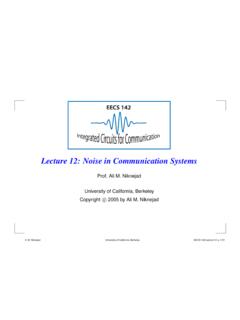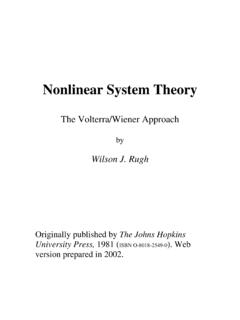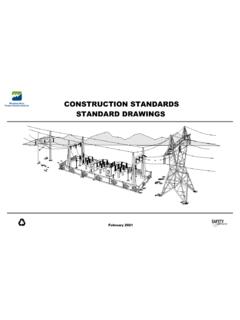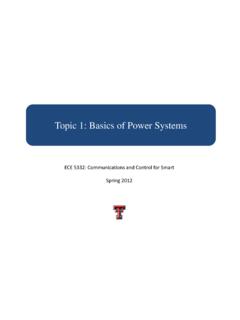Transcription of Matching Networks - University of California, Berkeley
1 Berkeley Matching Networks Prof. Ali M. Niknejad Berkeley Copyright c 2016 by Ali M. Niknejad February 9, 2016. 1 / 33. Impedance Matching RS ii io + +. Zin Matching Zout vi vo RL. network . RF design is all about impedance Matching . Inductors and capacitors are handy elements at impedance Matching . Viewed as a black-box, an impedance matcher changes a given load resistance RL to a source resistance RS . Without loss of generality, assume RS > RL , and a power match factor of m = RS /RL is desired. In fact any Matching network that boosts the resistance by some factor can be flipped over to do the opposite Matching . 2 / 33. Why Play the Matchmaker? Optimal Power Transfer: Maximize the power transfer from the source (say an antenna) and the load (say an amplifier). Most amplifiers have a capacitive input impedance and a small resistive part. Optimal Noise Figure: Build amplifiers that add the least amount of noise to a signal while performing amplification. We'l see that this depends on the source impedance, so you'll need to transform the source.
2 Minimum Reflections in Transmission Lines: Reflections cause dispersion/inter-symbol interference ( ghost in analog TV), and result in a sensitive input impedance when looking in the transmission line (changes with distance). Optimal Efficiency: Power amplifiers obtain maximum efficiency when we utilize the largest possible voltage swing at the drain (collector) node, requiring us to match the load to a value that satisfies the conditions on load power and load swing. 3 / 33. Matching Gain Since RL = vo /io and RS = vi /ii , we can see that this transformation can be achieved by a voltage gain, vi = kvo . Assuming the black box is realized with passive elements without memory, power conservation implies ii vi = io vo thus the current must drop by the same factor, ii = k 1 io , resulting in vi kvo vo Zin = = 1 = k 2 = k 2 RL. ii k io io . which means that k = m to achieve an impedance match. There are many ways to realize such a circuit block. Transformers are a natural choice but in this section we'll explore techniques employing inductors and capacitors.
3 4 / 33. Transmission Line Transformer Rs . Vs Z0 = RL Rs RL. /4 Note that a transmission i( /4) line has the desired v(0). properties of voltage/current gain if there's a standing wave on the line. v( /4) i(0). - - - - - . For example, if the source and load are both real impedances, then we can move from high/low impedance to low/high impedance by adding a quarter wave line. The voltage is maximimum at one end and minimum at the other end, and the opposite is true for the current. So in effect the transmission line is a voltage/current multiplier (resonator). 5 / 33. Capacitive and Inductive Dividers Zin Zin L1. C1. L C. C2 L2. RL RL. Perhaps the simplest Matching Networks are simple voltage dividers. Consider the capacitive voltage divider. At RF. frequencies, if RL X2 , then we can see that the circuit will work as advertised. Assuming that negligible current flows into RL , the current flowing into the capacitors is given by vi i=. j(X1 + X2 ). 6 / 33. Cap. Dividers (cont).
4 The voltage across the is therefore X2 1. vo = vC2 = jX2 i = vi = vi = kvi X1 + X2 1 + CC2. 1. which means that the load resistance is boosted by a factor of k2 . C2 2. Rin 1 + RL. C1. 7 / 33. An L-Match RS > R L RS > R L RS > R L. L C jX2. C RL L RL jX1 RL. (a) (b) (c). RS < R L RS < R L RS < R L. L C jX1. C RL L RL jX2 RL. (d) (e) (f). Consider the L- Matching Networks , named due to the topology of the network . We shall see that one direction of the L-match boosts the load impedance (in series with load) whereas the other lowers the load impedance (in shunt with the load). 8 / 33. L-Match as an RLC. Let's focus on the first two Networks shown. Here, in absence of the source, we have a simple series RLC circuit. Recall that in resonance, the voltage across the reactive elements is Q times larger than the voltage on the load! In essence, that is enough to perform the impedance transformation. Without doing any calculations, you can immediately guess that the impedance seen by the source is about Q 2 larger than RL.
5 Furthermore, since the circuit is operating in resonance, the net impedance seen by the source is purely real. To be sure, let's do the math. 9 / 33. Equiv. RLC. L. L. )R. RL. Q. +. RS > R L. (1. )L. =. 2. Q . p R. +. (1. =. L. C L Rp A quick way to accomplish this feat is to begin with the series to parallel transformation, where the load resistance in series with the inductor is converted to an equivalent parallel load equal to Rp = (1 + Q 2 )RL. where Q = XL /RL , and XL0 = XL (1 + Q 2 ). 10 / 33. Equiv. RLC (cont.). The circuit is now nothing but a parallel RLC circuit and it's clear that at resonance the source will see only Rp , or a boosted value of RL . The boosting factor is indeed equal to Q 2 + 1, very close to the value we guessed from the outset. 11 / 33. Norton Equiv. L. C RL L C RL. To gain further insight into the operation, consider an Norton equivalent of the same circuit. Now the circuit is easy to understand since it's simply a parallel resonant circuit.
6 We known that at resonance the current through the reactances is Q times larger than the current in the load. Since the current in the series element is controlled by the source voltage, we can immediately see that is = QiL , thus providing the required current gain to lower the load resistance by a factor of Q 2 . 12 / 33. Series Resonant Equiv. As you may guess, the mathematics will yield a similar result. Simply do a parallel to series transformation of the load to obtain Rp Rs =. 1 + Q2. Xp Xp0 =. 1 + Q 2. The resulting circuit is a simple series RLC circuit. At resonance, the source will only see the reduced series resistance Rs . 13 / 33. The Choice of Topology The following design procedure applies to an L-match using the generic forms. The actual choice between the forms depends on the application. For instance some provide AC. coupling (DC isolation) which may be required in many applications. In other applications a common DC voltage may be needed, making the Networks with DC coupling the obvious choice.
7 14 / 33. L-Match design Equations Let Rhi = max(RS , RL ) and Rlo = min(RS , RL ). The L- Matching Networks are designed as follows: Rhi 1 Calculate the boosting factor m = Rlo . Compute 2. the required circuit Q by (1 + Q ) = m, or 2. Q = m 1. 3 Pick the required reactance from the Q. If you're boosting the resistance, RS > RL , then Xs = Q RL . If you're dropping the resistance, Xp = RQL . 4 Compute the effective resonating reactance. If RS > RL , calculate Xs0 = Xs (1 + Q 2 ) and set the shunt reactance in order to resonate, Xp = Xs0 . If RS < RL , then calculate X. Xp0 = 1+Qp 2 and set the series reactance in order to resonate, Xs = Xp0 . 5 For a given frequency of operation, pick the value of L and C. to satisfy these equations. 15 / 33. Insertion Loss of an L-Match We'd like to include the losses in our passive elements into the design of the Matching network . The most detrimental effect of the component Q is the insertion loss which reduces the power transfer from source to load.
8 Let's begin by using our intuition to derive an approximate expression for the loss. Note that the power delivered to the input of the Matching network Pin can be divided into two components Pin = PL + Pdiss where PL is the power delivered to the load and Pdiss is the power dissipated by the non-ideal inductors and capacitors. The insertion loss is therefore given by PL PL 1. IL = = =. Pin PL + Pdiss 1 + PPdiss L. 16 / 33. Loss Calculation (cont.). Recall that for the equivalent series RLC circuit in resonance, the voltages across the reactances are Q times larger than the voltage across RL . We can show that the reactive power is also a factor of Q larger. For instance the energy in the inductor is given by 1 1 vs2. Wm = Lis2 = L. 4 4 4RS2. or 2 0 L v2. 1 vs 0 Wm = 4 4R = 12 s Q = 12 PL Q. S RS 8RS. where PL is the power to the load at resonance vL2 vs2 v2. PL = = = s 2RS 4 2 RS 8RS. 17 / 33. Reactive Power versus Load Power The total reactive power is thus exactly Q times larger than the power in the load 0 (Wm + We ) = Q PL (1).
9 By the definition of the component Qc factor, the power dissipated in the non-ideal elements of net quality factor Qc is simply PL Q. Pdiss = (2). Qc which by using the original forms of the equation immediately leads to the following expression for the insertion loss 1. IL = (3). 1 + QQc 18 / 33. Insights from Equation The above equation is very simple and insightful. Note that using a higher network Q, a higher Matching ratio, incurs more insertion loss with the simple single stage Matching network . Furthermore, the absolute component Q is not important but only the component Qc normalized to the network Q. Thus if a low Matching ratio is needed, the actual components can be moderately lossy without incurring too much insertion loss. Also note that the the actual inductors and capacitors in the circuit can be modeled with very complicated sub-circuits, with several parasitics to model distributed and skin effect, but in the end, at a given frequency, one can calculate the equivalent component Qc factor and use it in the above equation.
10 19 / 33. Reactance Absorption RS < R L. C. L Lres CL RL. In most situations the load and source impedances are often complex and our discussion so far only applies to real load and source impedances. An easy way to handle complex loads is to simply absorb them with reactive elements. For example, for the complex load shown, to apply an L- Matching circuit, we can begin by simply resonating out the load reactance at the desired operating frequency. For instance, we add an inductance Lres in shunt with the capacitor to produce a real load. From here the design procedure is identical. Note that we can absorb the inductor Lres into the shunt L- Matching element. 20 / 33. A -Match RS > R L RS > R L RS > R L. L C jX2. C1 C2 RL L1 L2 RL jX1 jX3 RL. The L-Match circuit is simple and elegant but is somewhat constrained. In particular, we cannot freely choose the Q of the circuit since it is fixed by the required Matching factor m. This restriction is easily solved with the - Matching circuit, also named from its topology.



